Recreational fishery monitoring and fish habitat research - Anderson Inlet Fisheries Reserve

Download the PDF version of this document Recreational Fishing Grant Program – Research report
Recreational Fishing Grant Program – Research report
PROJECT NUMBER 5/05/06/1
APRIL 2010
Simon Conron, Julia Kent and Jeremy Hindell
Executive Summary
The 2006 Anderson Inlet Fisheries Reserve Management Plan (AIFRMP) recognised that up to that time there had been little or no information collected on recreational fisheries and fish habitats that could be used to assess the appropriateness of existing fishery management arrangements for the estuary. In order to rectify this, the AIFRMP identified the following monitoring and research needs:
- Establishment of periodic access point surveys of recreational fishing in Anderson Inlet to obtain up-to-date information on the demographic profile of fishers, on the values they attach to fishing in the estuary, and on levels of satisfaction with recreational fishing experiences in Anderson Inlet. The first 12-month survey was to be conducted within 2 years of the declaration of the AIFRMP, and at least one more 12-month survey is to be conducted within the remaining life of the 10-year Plan.
- Monitor recreational fishery trends (preferred target species; species composition of catches; catch rates, size composition and discard rates for key species) through periodic access point creel surveys and the recruitment of recreational fishers to an on-going voluntary angler diary program.
- Monitor the stock status of key recreational target fish species through the on-going collection of catch rate and size/age composition data from volunteer 'research' angler diarists, and from periodic access point creel surveys. The initial focus in Anderson Inlet is to be estuary perch.
- Identify important habitats which support production of key recreational target species in Anderson Inlet, to enable more effective advocacy for protection of fish habitat to maintain fishery values. The initial focus in Anderson Inlet is to be on identifying habitat associations of estuary perch.
In response to these needs, the Fisheries Research Branch of Fisheries Victoria sought and received funds from the Recreational Fishing Licence Trust Fund and Fisheries Victoria for the following projects:
Conduct a 12-month access point survey of Anderson Inlet, commencing March 2007, to obtain recreational fishing
- demographic, attitudinal and catch/effort data
- Establish an on-going recreational general angler diary program for Anderson Inlet to provide information on catch composition and catch trends for key species
- Establish an on-going 'research' angler diary program to provide detailed catch rate and size/age structure data needed to monitor the recruitment of estuary perch, and to facilitate stock assessment and adaptive fishery management of this species
- Conduct a 12-month survey of fish/habitat associations in Anderson Inlet in 2006/07, in conjunction with stable isotope analysis of fish stomach contents, to provide information on important habitats for key target species – particularly estuary perch.
Main Findings from Monitoring/Research Projects
The major findings to date of the above monitoring and research projects are:
- Results from the seasonal survey of fishers indicated that in 2007/08 about 30-50% of Anderson Inlet recreational fishers were local South Gippsland residents, 25-35% were visitors from the Greater Melbourne metropolitan area, and 20-30% were visitors from elsewhere.
- During all seasons the main age-group of fishers surveyed was 18-49. The percentage of both under 18 (20%) and those over 70 interviewed was highest in autumn. Fishers in the 50-69 age category were recorded mainly in summer and spring.
- Overall satisfaction with recreational fishing experiences in Anderson Inlet is high (> 90% for both boat and shore anglers) and exceeds the performance target of 60% set in the AIFRMP.
- Anglers value fishing in Anderson Inlet for a variety of reasons. Some of these reasons are not directly related to catching fish, but all are underpinned by an expectation that fish can be caught. The 2007/08 survey of fishers indicated that a majority of both shore-based (58%) and boat-based (69%) recreational fishers listed a non-catch value as their primary motivation for fishing, although enjoying fishing as a sport was still important.
- The 2007/08 survey of fishers indicated that the most popular target species for both boat- and shore-based anglers in Anderson Inlet were King George whiting, Australian salmon, and flathead (mostly sand flathead), although many anglers had no specific target species. The survey also indicated that while estuary perch are keenly sought after by some, the majority of Anderson Inlet anglers are not targeting this species.
- Data from 'research' angler diaries and from the 2006/07 fish habitat survey indicate that estuary perch have been abundant in Anderson Inlet in recent years, with a number of comparatively strong cohorts both above and below the legal minimum length.
- A total of 48 fish species were sampled in the 2006/07 Anderson Inlet fish habitat survey, including 19 species of recreational fishing value. Both adult and juvenile stages of many recreational species were sampled.
- The fish habitat survey found that small estuary perch (<15 cm length) were found mostly in the upper riverine sections of the Anderson Inlet estuary, while larger perch (>20 cm) were found throughout the estuary. There is also some evidence that at certain times of the year adult perch segregated by sex and were found in different parts of the estuary.
- There was no strong evidence of specific habitat preferences by fish species in Anderson Inlet, with the exception of species known to be seagrass-dependant. Despite the very small areas of seagrass in the Inlet, early post-settlement stages of King George whiting and other seagrass-dependent species were sampled in the fish habitat survey, and recreational catches of King George whiting in the inlet have been good in recent years.
- Stable isotope analyses showed that, while Anderson Inlet estuary perch consumed food items derived from a variety of different types of food webs, nutrition derived from a seagrass base was the single most important component. The results also indicate that estuary perch derive a significant amount of nutrition from the introduced cord grassSpartina.
Introduction
This Report describes the results of recreational fishery monitoring and fish habitat assessment projects funded by the Recreational Fishing Grants Program and Fisheries Victoria and conducted in accordance with the requirements of the 2006 Anderson Inlet Fisheries Reserve Management Plan (AIFRMP).
Description of Anderson Inlet
Anderson Inlet is a small (about 20 km2) lagoonal estuary in South Gippsland, located near Inverloch, about 140 km south-east of Melbourne. The estuary has a catchment area of about 1,600 km2 and most of the freshwater inflow is from the Tarwin River.
The Anderson Inlet lagoon is shallow, with about 85% of the area consisting of intertidal mud or sand flats (both bare and vegetated), and the remaining 15% consisting of channels and islands. Significant areas of Anderson Inlet have been colonized by the aquatic pest plant Spartina, originally introduced to Anderson Inlet to control erosion. A spraying program to control Spartina has resulted in substantial reductions in area in recent years.
The climate of Anderson Inlet is typical of coastal areas of south-east Victoria, with generally warm to hot dry summers and cold, wet winters.
On 3 July 2003, Anderson Inlet was declared a fisheries reserve under the provisions of section 88 of theFisheries Act 1995. The defined area of the Anderson Inlet Fisheries Reserve is the waters of the Anderson Inlet lagoon and the Tarwin River below the Tarwin Lower Road Bridge, but not including any intertidal areas that have been included as part of the Cape Liptrap Coastal Park. An Anderson Inlet Fisheries Reserve Management Plan was developed by Fisheries Victoria in partnership with key stakeholders, and was declared in April 2006.
Following the closure of commercial fishing in 2000, fisheries management in Anderson Inlet has been focused on maintaining or improving the recreational fishing opportunities.
Management Plan Requirements
The broad management goal specified in the AIFRMP is to manage Anderson Inlet fish stocks, the habitats on which they depend and the fisheries they support, in a manner that is sustainable, and which provides optimum social and economic benefits to all Victorians in accordance with Ecological Sustainable Development (ESD) principles (DPI 2006). The following main objectives are also identified:
Social: to maintain, and where possible, enhance recreational fishing opportunities in Anderson Inlet.
Biological: to conserve and ensure sustainable use of key fish stocks in the inlet.
Environmental: to identify and promote protection of the habitats and environments which are essential for production or maintenance of key fish stocks in the inlet.
Governance: to achieve maximum community participation, understanding and support for the management of fishing activities in the Anderson Inlet Fisheries Reserve.
The AIFRMP recognized that up to 2006, there had been little or no information collected on Anderson Inlet recreational fisheries and fish habitats that could be used to assess the appropriateness of existing fishery management arrangements for the estuary. In order to rectify this, the AIFRMP identified the need to establish several recreational fishery monitoring programs and to undertake specific fish habitat research.
Fish species initially identified as being of recreational fishing importance in the AIFRMP were estuary perch (Macquaria colonorum), Australian salmon (Arripis trutta/truttacea), silver trevally (Pseudocaranx dentex), black bream (Acanthopagrus butcheri), sand flathead (Platycephalus bassensis) and yellow-eye mullet (Aldrichetta forsteri) (DPI 2006).
Preliminary information from public consultations during the development of the AIFRMP indicated that estuary perch and Australian salmon were the two most important recreational target species in Anderson Inlet. Resources available for monitoring and assessing the status of key target fish stocks were initially focused on estuary perch. As this species generally spends its entire life cycle in estuaries such as Anderson Inlet, abundance is likely to be determined predominantly by habitat, environmental and/or fishing factors within the estuary.
Purpose of this report
Strategies listed in the 2006 AIFRMP that required the establishment of recreational fishery monitoring and fish habitat research projects include:
Strategy 1: Identify fishing values in Anderson Inlet.
Strategy 2: Maintain or enhance levels of satisfaction with fishing opportunities.
Strategy 4: Identify key target species and monitor fishery trends for these species.
Strategy 5: Determine the status of key target fish stocks
Strategy 7: Identify important habitat for key fishery species.
In response to these needs, the Fisheries Research Branch of Fisheries Victoria sought and received funds from the Recreational Fishing Licence Trust Fund and Fisheries Victoria for the following projects:
- Conduct a 12-month access point survey of Anderson Inlet, commencing March 2007, to obtain recreational fishing demographic, attitudinal and catch/effort data
- Establish an on-going recreational general angler diary program for Anderson Inlet to provide information on catch composition and catch trends for key species
- Establish an on-going 'research' angler diary program to provide detailed catch rate and size/age structure data needed to monitor the recruitment of estuary perch, and to facilitate stock assessment and adaptive fishery management of this species
- Conduct a 12-month survey of fish/habitat associations in Anderson Inlet in 2006/07, in conjunction with stable isotope analysis of fish stomach contents, to provide information on important habitats for key target species – particularly estuary perch.
This report presents the results of these projects, specifically:
- Data from the 2007/08 access point recreational fishing survey on:
- The demographic profile, fishing values and satisfaction levels of Anderson Inlet anglers
- Target species preferences\
- Catch composition and discards
- Size/age composition of key species
Initial results from the ongoing 'research' angler diary program on:
- Size composition of estuary perch in Anderson Inlet
- Age composition of estuary perch in Anderson Inlet
Data from the 2006/07 fish habitat study and an associated estuary perch nutrition study on:
- Which Anderson Inlet habitats are used by recreational target fish species (with a focus on estuary perch)
- The contribution of different food webs to the nutrition of estuary perch in Anderson Inlet.
Fishing Values and Preferences
Strategy 1 of the AIFRMP identifies a need to collect information on the demographic profile of Anderson Inlet recreational fishers and on the values they attach to fishing in the Inlet. This information is needed to determine what constitutes a satisfying recreational fishing experience in the Inlet, and therefore, what management actions may help to maintain or enhance recreational fishing opportunities.
Methods
An initial profile of Anderson Inlet recreational fishers was obtained from on-site interviews conducted during seasonal (summer, autumn and spring) access point creel surveys in Anderson Inlet from March 2007 to December 2008. The age and postcode were recorded from a randomly selected individual in each fishing party. Recreational fishers indicated whether they were locals or visitors, answered questions on their main motivations for going recreational fishing, and indicated the specific reasons they chose to fish in Anderson Inlet. From the information given it was determined whether they were eligible for a Recreational Fishing Licence (RFL).
Primary motivations for going fishing have been grouped into non-catch (do not directly depend on fish being caught) or catch (depend on fish being caught) categories. However, all types of motivations for going fishing are underpinned by an expectation that fish can be caught from the waters in question.
Results
Fishers in summer were mainly locals (33%), from Melbourne (35%), or visiting from Gippsland (28%), with a small number of fishers from other parts of Victoria (4%) (Figure 1). During autumn, over half of fishers interviewed were locals (53%), and a quarter were from Melbourne (26%, Figure 1). Other visitors in autumn were either from Gippsland, other parts of country Victoria, or from New South Wales. In winter, most fishers were again either from the local area (47%) or Melbourne (36%), with fewer numbers from Gippsland and other parts of Victoria (Figure 1).
During all seasons, the main age-group of fishers surveyed was 18-49 (Figure 2). The percentage of both under 18 (20%) and those over 70 (17%) interviewed was highest in autumn (Figure 2). Fishers in the 50-69 age category were recorded mainly in summer and spring (Figure 2).
The majority of fishers in all seasons were deemed eligible for a RFL; however this percentage was far higher in summer (82%, Figure 3). In autumn, 60% of those surveyed would have required a licence (Figure 3).
A total of 166 fishing parties, 68 boat-based and 98 shore-based, answered questions on what motivates them to participate in recreational fishing in Anderson Inlet. Most boat-based anglers (29%) reported that their most important reason for fishing was relaxation (a non-catch value) followed by the enjoyment of the sport (a catch value) (24%) (Figure 4). For shore-based anglers, the most common answer was, 'the enjoyment of the sport of catching fish', which was given by 38% of those surveyed (Figure 4). No anglers stated that their most important reason was to participate in fishing competitions. Overall, non-catch values were more important than catch values to all anglers, but more so for boat-based anglers.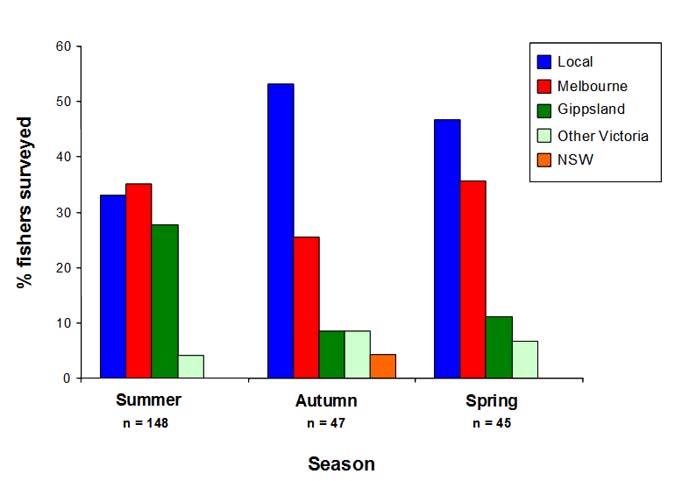
Figure 1. Origin of fishers selected randomly from fishing parties participating in onsite surveys in Anderson Inlet between March 2007 and December 2008.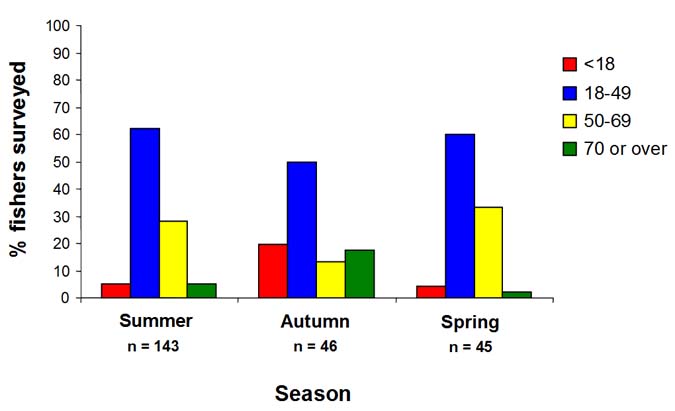
Figure 2. Percentage of age categories of individuals selected randomly from fishing parties participating in onsite surveys in Anderson Inlet between March 2007 and December 2008.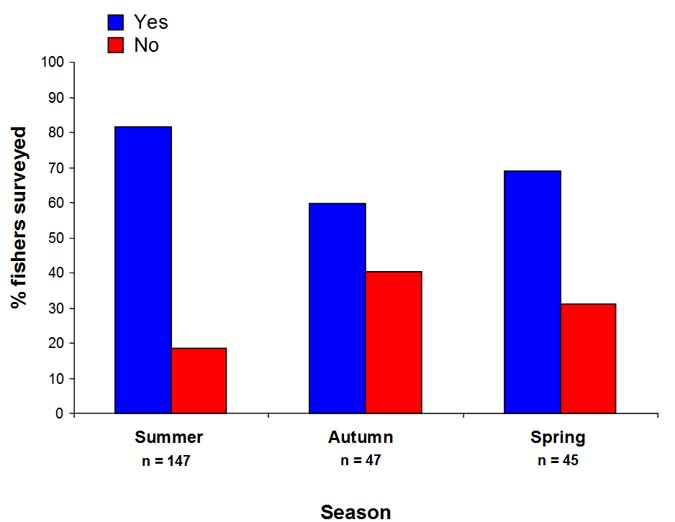
Figure 3. Percentage of fishers randomly selected from fishing parties participating in onsite surveys in Anderson Inlet between March 2007 and December 2008 who were deemed eligible for a recreational fishing license (RFL).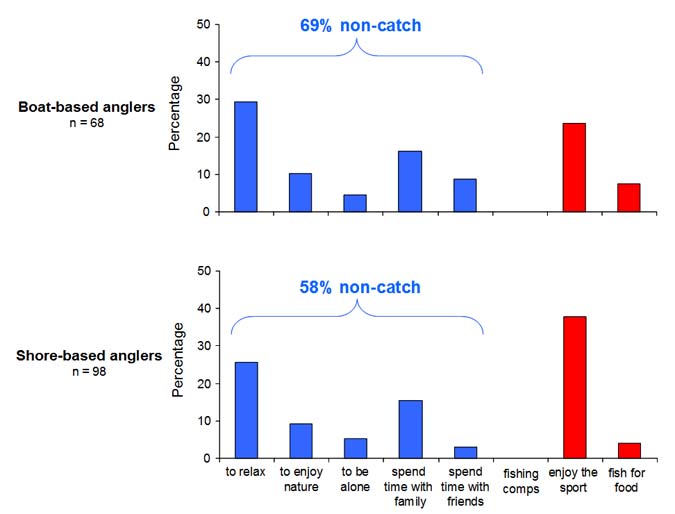
Figure 4. Reasons for fishing which were rated as most important by boat and shore-based anglers participating in onsite surveys in Anderson Inlet between March 2007 and December 2008. Values are either non-catch (do not depend on fish being caught: blue bars) or catch (depend on fish being caught: red bars).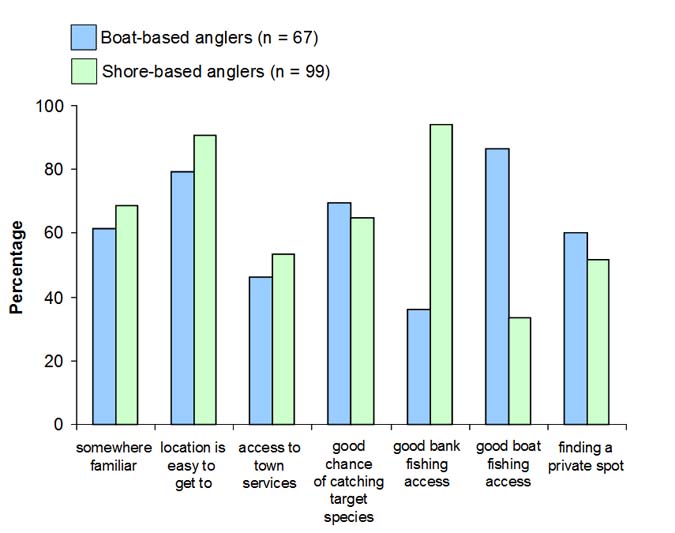
Figure 5. Reasons for fishing specifically in Anderson Inlet which were rated as either 'Very important' or 'Quite important' by boat-based (blue bars) and shore-based (green bars) anglers participating in onsite surveys in Anderson Inlet between March 2007 and December 2008.
A high percentage of boat-based anglers (86%) rated having good boat fishing access as important (Figure 5). The majority of shore-based anglers (94%) reported that having good bank fishing access was important (Figure 5). The responses concerning the importance of the other reasons were similar between boat and
shore-based anglers. Having a location that is easy to get to was rated as important by all anglers, as was having a good chance of catching a target species and familiarity with the location. Access to town services and finding a private spot were not as important as other reasons (Figure 5).
Monitoring Fishing Satisfaction Levels
Strategy 2 of the AIFRMP identifies the need to conduct periodic surveys to initially benchmark and then detect any changes in levels of recreational fishing satisfaction in Anderson Inlet. The performance indicator set in the AIFRMP is a minimum of 60% of fishers satisfied with fishing opportunities (DPI 2006).
Methods
An initial profile of levels of satisfaction among Anderson Inlet recreational fishers was obtained from on-site interviews conducted during seasonal (summer, autumn, and spring) access point creel surveys in Anderson Inlet from March 2007 to December 2008. Anglers were asked how satisfied they were with the overall quality of their fishing experiences in Anderson Inlet in the previous 12 months. A total of 164 anglers participated in the satisfaction survey, of which 67 were boat-based and 97 were shore-based.
Results
Levels of satisfaction with recreational fishing experiences in Anderson Inlet were extremely high (>90%) for both boat- and shore-based anglers (Figure 6). For those that were not satisfied, the most common reasons given were low catch rates and, for boat anglers, the condition of the boat ramp at Inverloch.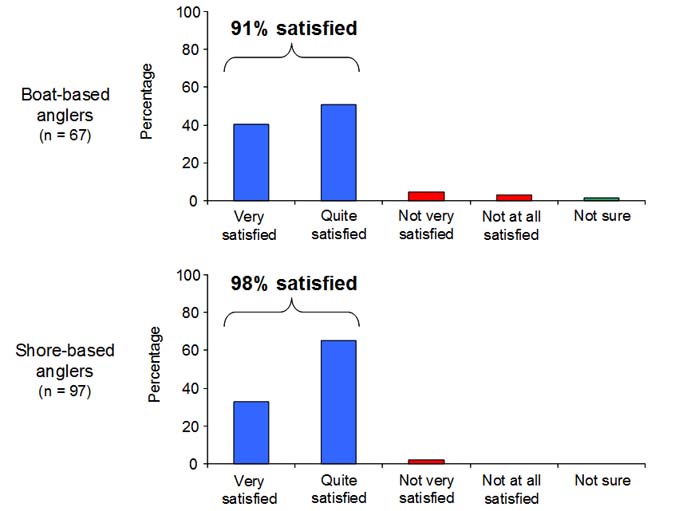
Figure 6. Levels of fishing satisfaction indicated by boat- and shore-based anglers participating in onsite surveys in Anderson Inlet between March 2007 and December 2008.
Fish Species Targeted and Caught
Strategy 4 of the AIFRMP identifies a need for ongoing periodic monitoring of recreational fishing in Anderson Inlet to identify, and then detect, subsequent changes to preferred target species and the species composition of the catch. This information is needed to ensure that fishery monitoring, assessment and management activities are focused on the most important target species, and to provide a capacity to detect changes in the fishery that may require a management response.
Methods
Information on preferred fishing target species, and on the species composition of both retained and released catches, was obtained from onsite interviews with fishing parties conducted during seasonal (summer, autumn, and spring) access point creel surveys in Anderson Inlet from March 2007 to December 2008. Anglers were asked which species they had been fishing for, how many of each species were caught, and how many of these were retained or released. A total of 325 fishing parties were interviewed, of which 157 were boat-based and 168 shore-based.A general angler diary program was also established to provide supplementary on-going data relating to preferred target species and the species composition of recreational catches in Anderson Inlet. This information has been collected and reported for a three year period (2007-2009) (Conronet al. 2010).
Results
PREFERRED TARGET SPECIES
Responses from the 2007-08 access point survey indicated that King George whiting was the most popular target species for boat-based anglers in all seasons surveyed (Table 1, Figure 7), but particularly in summer whenit was targeted by 60% of all Anderson Inlet boat-based anglers.
King George whiting was also a key target species preferred by between 21% and 36% of shore-based anglers depending on season (Table 1, Figure 7).
These results suggest that King George whiting is now a more popular recreational target species in Anderson Inlet than was indicated from public consultation on the development of the AIFRMP in 2005, or from the results of the only previous recreational fishing survey in Anderson Inlet in 1989/1990 (Smith 1991).
Seasonally popular recreational target species include Australian salmon (targeted by 29% of shore-based anglers in spring and 23% of boat-based anglers in autumn), flathead (21% of boat-based anglers in autumn) silver trevally (28% of shore-based anglers in autumn) and gummy shark (13% - 15% of boat-based anglers in spring and summer). Other minor target species included snapper, yellow-eye mullet and crab (Figure 7).
Despite the high profile given to estuary perch fishing in the Anderson Inlet estuary, fewer than 10% of either boat-based or shore-based anglers surveyed indicated that they were targeting this species (Figure 7).In all seasons surveyed there were both boat-based and shore-based anglers who did not have a specific target species and were fishing for anything they could catch (Figure 7). In general the proportion of shore-based anglers without a target species was higher than for boat-based anglers, with almost a quarter of shore-based anglers fishing for 'anything' in summer, and 44% in autumn (Figure 7). The percent of boat-based anglers fishing for 'anything' was greatest in summer (15%).
A summary of the most popular target species of boat and shore-based anglers in each season surveyed is shown in Table 1.
Table 1. Most popular target species by season for boat and shore-based anglers who participated in onsite surveys in Anderson Inlet from March 2007 – December 2008.
| Summer | Autumn | Spring | ||||
|---|---|---|---|---|---|---|
| Angler type |
Most common target species |
2nd most common target species |
Most common target species |
2nd most common target species |
Most common target species |
2nd most common target species |
| Boat |
King George whiting (60%) |
Gummy shark (15%) |
King George whiting (32%) |
Australian salmon (23%) |
King George whiting (48%) |
Gummy shark (13%) |
| Shore |
King George whiting (36%) |
Australian salmon (11%) |
Silver trevally (28%) |
King George whiting (22%) |
Australian salmon (29%) |
King George whiting (21%) |
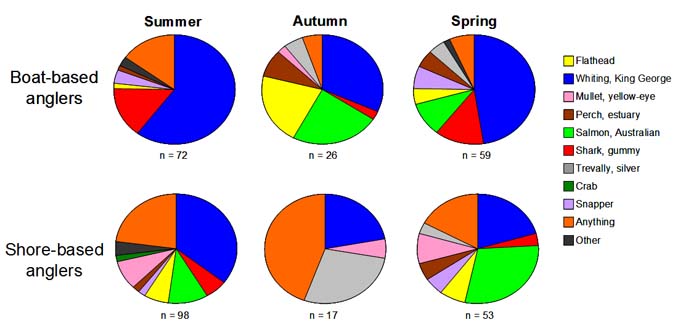
Figure 7. Target species reported by boat and shore-based anglers who participated in seasonal onsite surveys in Anderson Inlet between March 2007 and December 2008 (n = number of responses).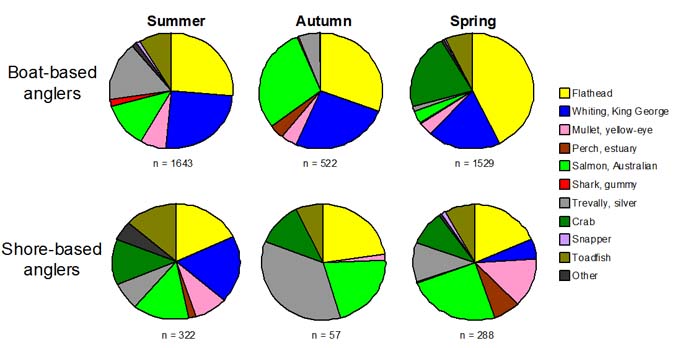
Figure 8. Species composition of catches reported by boat and shore-based anglers who particpated in seasonal onsite surveys in Anderson Inlet between March 2007 and December 2008. (n = number of fish caught).
SPECIES COMPOSITION OF CATCHES
Sand flathead was the biggest component of the boat-based recreational catch in Anderson Inlet and, together with King George whiting, made up at least 50% of the total catch in all seasons (Figure 8). Sand flathead was also a major component of shore-based angling catches, constituting 18 -23% of total catches in all seasons. The prominence of sand flathead in catches (Figure 5) compared with its modest status as a target species (Figure 7) suggests that a significant portion of flathead are caught while targeting other species, or are caught by anglers who are not targeting any species in particular. The total length of flathead in the retained catch ranged from 21 to 54 cm (Figure 9). Flathead below the legal minimum length (LML) (25 cm) comprised of 15% of the retained catch.
King George whiting were a major component (18-25%) of boat-based angling catches in all seasons surveyed, but were only prominent in the summer catches of shore-based anglers (18%) (Figure 8). The total length of King George whiting in the retained catch ranged from 27 to 49 cm (Figure 9).
Australian salmon were a significant component (15% - 25%) of total shore-based catches in all seasons, but were most prominent in the autumn catches (29%) of boat-based anglers (Figure 8). The total length of Australian salmon in the retained catch ranged from 23 to 44 cm (Figure 9).
The 2007/08 Anderson Inlet access point survey indicated that crabs were collected in significant quantities by shore-based recreational fishers in all seasons, and constituted 21% of total boat-based catches in spring (Figure 8).
Silver trevally and yellow-eye mullet were caught in relatively small quantities by both boat-based and shore-based anglers in all seasons (Figure 8). The prominence of silver trevally in autumn catches of shore-based anglers needs to be treated with some caution because of the small sample size involved.
Estuary perch were only caught in small numbers by boat-based anglers in autumn and by shore-based anglers in spring and summer. Other species caught in small numbers, mainly by boat-based anglers, included gummy shark and snapper.
Both shore-based and boat-based anglers reported catching small quantities of toadfish (Figure 8), a species which is almost always considered undesirable and released (Figure 10).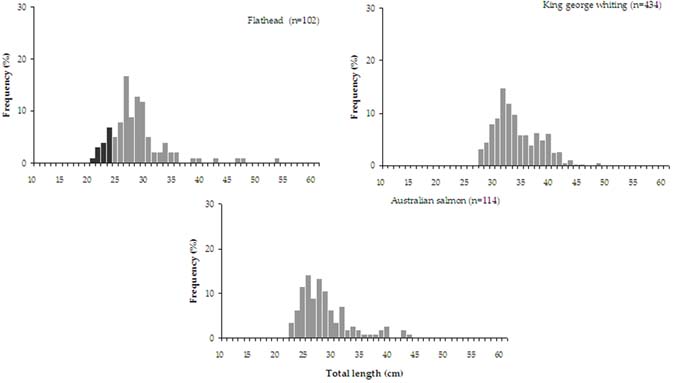
Figure 9. Length distribution of flathead (all species), King George whiting and Australian salmon retained by anglers fishing in Anderson Inlet for 2006/07 (n = number of fish measured). *A LML for flathead of 25 cm was in place at the time of this study.
PROPORTION OF CATCH RELEASED
A number of factors can influence whether or not recreational fishers release the fish they catch, including the eating qualities of the species, whether the fish exceeds size or catch limit restrictions, or whether the fisher practices catch and release.
Boat-based anglers
The species which were most often caught and retained by boat-based anglers in Anderson Inlet were snapper (74% of total catch retained), crabs (69%), King George whiting (59%), yellow-eye mullet (56%) and Australian salmon (53%) (Figure 10a). Almost all toadfish (99.6%), and most flathead (87%) caught by boat-based anglers were released. Silver trevally, estuary perch and gummy shark caught were all more likely to be released than retained (Figure 10a). Overall, more fish or invertebrates were released (63%) than retained by boat anglers surveyed in Anderson Inlet.
Shore-based anglers
The species most frequently retained when caught by shore-based anglers were King George whiting (64%) and yellow-eye mullet (63%) (Figure 10b). Smaller proportions of Australian salmon (38%), crab (34%), snapper (33%) and silver trevally (31%) were retained (Figure 10b). All toadfish and most flathead (91%) caught by shore-based anglers were released (Figure 10b).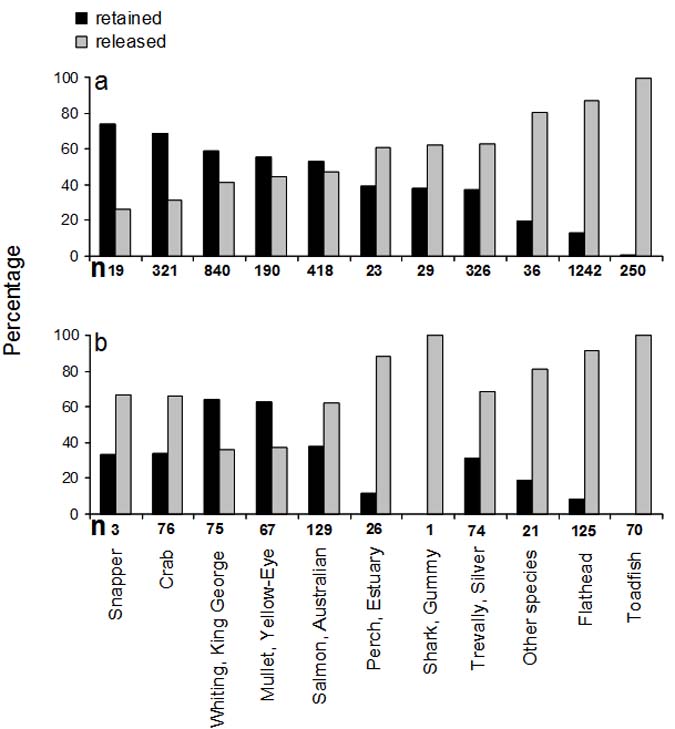
Figure 10. Percentage of each species caught in Anderson Inlet that was retained (black bars) or released (grey bars) as reported by boat-based (a) and shore-based (b) anglers participating in onsite surveys between March 2007 and December 2008.
Status of Key Target Fish Stock
Strategy 5 of the AIFRMP identified a need to establish ongoing or periodic monitoring of year class strength and fishery recruitment patterns for key recreational target fish species in Anderson Inlet to facilitate stock assessment and fishery management decision making. The AIFRMP specifies that the initial stock assessment focus in Anderson Inlet will be on estuary perch.
Methods
Experienced anglers who targeted estuary perch (or other popular species) in Anderson Inlet were identified and recruited in October 2006 to participate in an ongoing voluntary 'research' angler diary program. Information recorded by these anglers and provided to FRB includes:
- time spent fishing
- fishing location
- species targeted and caught
- length of each fish caught
- number of rods
- bait and hook type/sizes used.
'Research' anglers are asked to adjust their fishing techniques (hook sizes, baits and fishing locations) so that they can effectively target and catch both small (<25 cm) and large (>25 cm) estuary perch. All catch data including the release of under-size fish, were recorded in diaries, and all fish caught were measured. Anglers were asked to record details of every fishing trip, including those in which no fish were caught, to avoid non-reporting of poor catches. The results reported below are derived from diary records of fishing events that occurred between October 2006 and June 2007.In addition to the ongoing research angler fishing diary program, a one-off scientific netting survey was undertaken as part of an Anderson Inlet fish habitat study in 2006/07 (see page 18). This survey provided additional information on the size composition of estuary perch in Anderson Inlet, and otoliths were obtained from a sample of the perch caught in this survey for the purposes of ageing.
Results
During the period October 2006 to June 2007, 'research' angler diarists reported catching a total of 403 estuary perch in Anderson Inlet. These perch were caught over 22 fishing trips with a mean catch rate of 5.0 perch per angler hour.
The size composition of estuary perch caught by angler diarists ranged from 16 to 52 cm total length (TL), with a modal length of 33 cm (Figure 11). Estuary perch below the then LML of 25 cm comprised 14% of the catch, but few fish less than 20 cm TL were caught. Few fish were caught which were over 40 cm (Figure 11).
By contrast size composition of estuary perch caught by netting was multi-modal, ranging from 7 to 42 cm TL (Figure 12). Estuary perch below the LML of 25 cm comprised 66% of the catch. The trawl was more effective than the mesh net in catching estuary perch below the LML, but caught few fish above the LML. Few fish over 35 cm were caught by mesh nets (Figure 12).
Estuary perch in Anderson Inlet ranged from 0+ to 30+ years of age (Figures 13 and 14). The age composition of the research angler catch shows a number of separate year classes were represented, with the 1993/94 (12+ years) and the 1989/90 (16+ years) cohorts being particularly dominant (Figure 12). A high proportion (60%) of older estuary perch (>10 years) were caught (Figure 13). The age composition of the netted sample shows the presence of additional younger year classes from more recent spawning years with the 2004/05 cohort being particular dominant (Figure 14).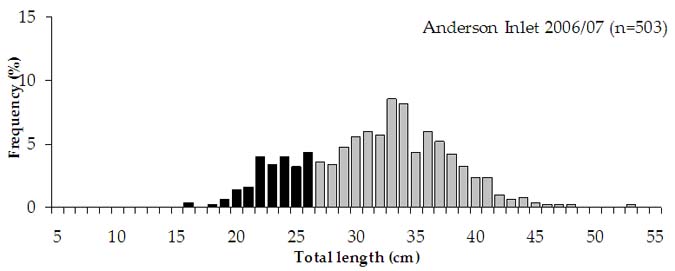
Figure 11. Length (TL) distribution of estuary perch caught by research anglers fishing in Anderson Inlet for 2006/07 (n = number of fish measured). *The LML for estuary perch (25 cm) was revised and the new LML of 27 cm TL became effective in March 2009.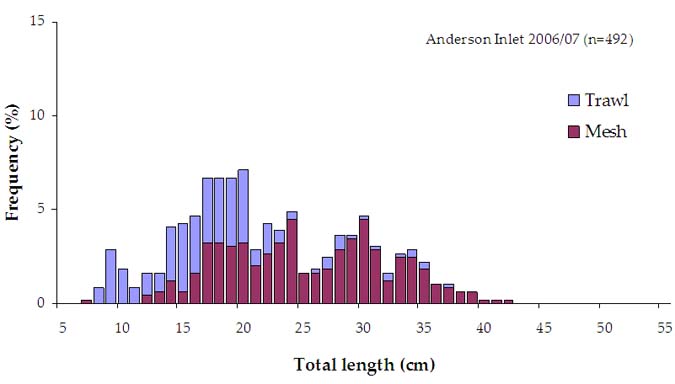
Figure 12. Length (TL) distribution of estuary perch caught by mesh and trawl net in Anderson Inlet for 2006/07 (n = number of fish measured).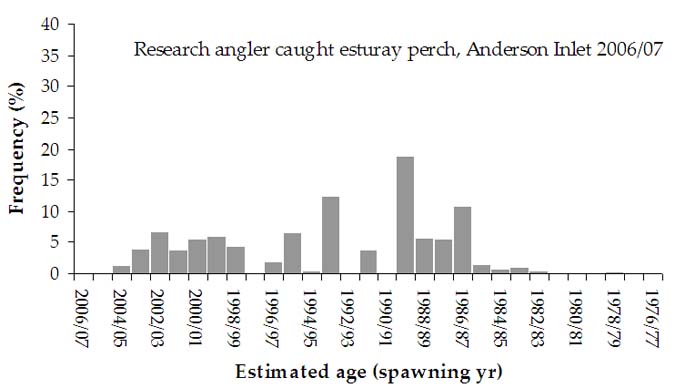
Figure 13. Estimated age distribution of estuary perch caught by 'research' angler diarists fishing in Anderson Inlet during 2006/07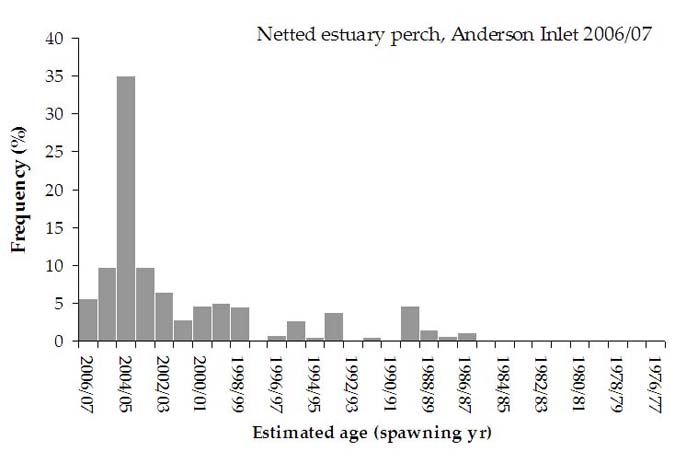
Figure 14. Esitmated age distribution of estuary perch caught by mesh and trawl nets in Anderson Inlet for 2006/07
Fish Habitat Research
Physical Habitat Associations of Fish in Anderson Inlet
Strategy 7 of the AIFRMP specifies a need to identify habitats (e.g. seagrass/algae beds, unvegetated sand/mud areas, mangroves, Spartina affected areas) that are important in supporting production of various life stages of key fishery target species in Anderson Inlet – with a particular focus on estuary perch. This information is needed to facilitate more effective advocacy for protection of essential fish habitat – and therefore fishery values – from the potential impacts of a range of human fishing and non-fishing activities. This information is also potentially useful in assessing the impacts of climate change on production of fish resources in estuaries such as Anderson Inlet.
An assessment of the extent to which key fishery species use or avoid Spartina-dominated habitats in Anderson Inlet will be useful in determining the consequences of further spread or successful control of this invasive species.
The physical habitat associations of key fishery species in Anderson Inlet were investigated during a 12-month scientific survey conducted in 2006/07. This survey focussed on estuary perch, as this species spends its entire life cycle in Anderson Inlet and is likely to be affected by local environmental and fishing factors.
Methods
Seasonal scientific netting surveys of fish were conducted in the Tarwin River, Screw Creek and Pound Creek, and at Venus Bay (2 sites), Inverloch and throughout the main channel in the Inlet proper (Figure 7). Surveys were carried out in November 2006, February 2007, May 2007 and August 2007.
Sampling was conducted in or near seven different habitat types: the inlet channels, mangroves,Phragmites (a large native reed grass), rock wall, seagrass, Spartina and the Tarwin River. Water quality data were collected at each site. When sampling began (November 2006), Spartina had invaded an extensive area of Anderson Inlet; however, control measures by the West Gippsland Catchment Management Authority had significantly reduced this area by the end of the project (August 2007). As a result of this, sampling of Spartina was only carried out in Venus Bay in February 2007.
Four types of netting methods were used in each survey: experimental mesh (gill) nets with multiple mesh sizes, fyke nets, a haul seine net, and a trawl net. Fish were sampled using a subset of the most effective gear types listed below. A summary of the gear used throughout the sampling is shown in Appendix 1. Estuary perch were counted and their lengths measured to provide information on habitat preferences of different size classes.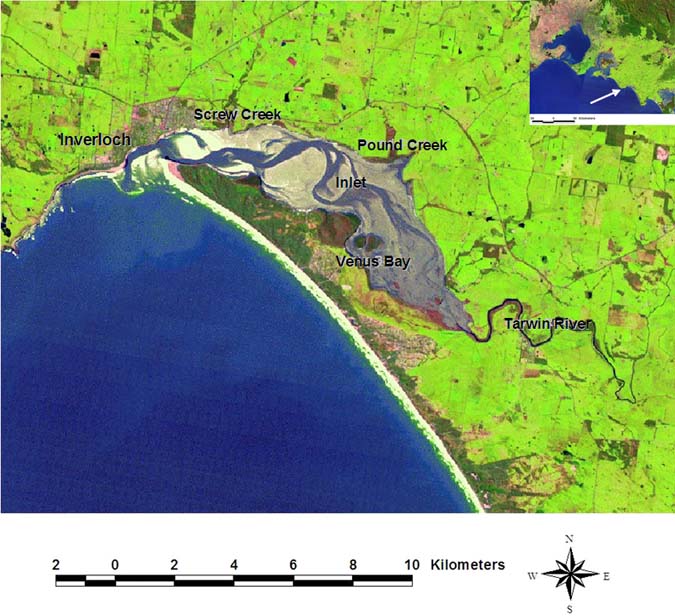
Figure 15. Aerial picture of Anderson Inlet showing primary sampling locations. Inset: Location of Anderson Inlet along the Victorian coastline.
Results
A total of 48 fish species were recorded from the 2006/07 seasonal surveys, including 19 species of recreational fishing value (Appendix 2). Both adult and juvenile stages of many recreational species were sampled, although the effectiveness of different netting methods in catching each species varied considerably (Appendix 3).
The majority of species were found in multiple locations and in or next to multiple habitat types (Appendix 2, 4). The greatest diversity of sub-adult / adult recreational species was found in the channels of the inlet using the otter trawl (Appendix 3-4). Benthic species like flounder and flathead were most common in this environment, but several demersal and pelagic species such as trevally, Australian salmon, estuary perch and yellow-eye mullet were also caught. Waters in or next to mangroves also contained a high number of species, including important recreational species such as Australian salmon, estuary perch, silver trevally and sand flathead (Appendix 4). A suite of fish commonly associated with mangroves and saltmarshes was also sampled next to Spartina habitat (Appendix 4).
The seasonal surveys provided little evidence of strong preferences by fish for a particular habitat type, with the exception of fish known to be seagrass-associated. Seagrass habitat appeared to be important for small and/or juvenile stages of many (including recreational) species, despite only one area within the Inlet containing seagrass in reasonable condition (i.e. fronds were long and thick). A significant area of seagrass was also found in Screw Creek, and was the only habitat in which juvenile King George whiting were found (Appendix 4).
DISTRIBUTION OF ESTUARY PERCH
The most commonly sampled species of recreational fishing importance was estuary perch (Macquaria colonorum), with 413 individuals caught over all seasonal surveys (Appendix 3). Estuary perch were sampled year-round, with highest numbers caught in August 2007 (35% of total caught, Appendix 2).
The experimental otter trawl was the most effective method for sampling small (7-20 cm TL) estuary perch. Mesh nets with mesh sizes from 2.5 to 7.6 cm were effective at catching estuary perch from 15 cm to 40 cm. Fyke nets and haul seines were not very effective at catching estuary perch.
The distribution of estuary perch throughout the estuary and among habitat types varied from season to season, but overall they were most common in the Tarwin River (54%, Appendix 2) and in or next to mangroves and the inlet channels (Appendix 4).
Small estuary perch (< 150 mm TL) were found almost exclusively in the middle to upper regions of the Tarwin River estuary. Larger fish (> 200 mm TL) were common in the estuaries and in the Inlet. No larval or post-settlement (10-20 mm TL) estuary perch were caught.
There was some evidence of spatial structuring of sexes in November and February, when females were more common in the lower regions of the rivers entering Anderson Inlet, and males were found mainly in and around the mangrove-lined regions of the lower inlet. Sampling in May and August found greater mixing between the sexes.
The size distributions of fish caught were similar for male and female estuary perch, and examination of gonads suggested that estuary perch first attain sexual maturity at around 20 cm, with all fish sexually mature by 30 cm.
WATER QUALITY
Salinity in the Tarwin River is governed by a mixture of freshwater inputs and tidal exchange from the lower reaches of the estuary. Screw and Pound Creeks are also estuarine in nature. In November 2006 and February 2007 salinities in the lower regions of the Tarwin River approached 30 ppt due to low freshwater inputs (Appendix 5), and probably contributed to upstream movement of some marine species.
Significant rainfall in late autumn and early winter 2007 lowered winter salinities in the Tarwin River and the upper part of the inlet proper. August 2007 salinities were lower at Venus Bay east (Appendix 5), but the remainder of the inlet proper was predominantly marine or hypersaline (salinities > 34 ppt) for most of the study (Appendix 5).
Trophic (Food Web) Dependencies of Estuary Perch in Anderson Inlet
The 2006/07 Anderson Inlet fish habitat survey provided information on which habitat types fish are physically associated with, but does not necessarily indicate which habitats support food webs that the fish depend on for survival and growth.
The diet of estuary perch caught during the 2006/07 habitat survey was therefore examined using stable isotope analysis to establish which types of habitat were sources of base nutrition for estuary perch in Anderson Inlet (Hindell 2008).
This study helps to addresses AIFRMP Strategy 7 by identifying habitats that estuary perch are dependent on for nutrition.
Stable isotopes are variant forms of common chemical elements (e.g. carbon and nitrogen) that do not degrade (i.e. are not radioactive). Each plant type (e.g. seagrass, algae or phytoplankton) has a distinctive stable isotopic profile. When plant matter is consumed by an organism, the isotopic signals in the organism are altered in a predictable way. Analysis of the isotopic signals indicates which types of vegetation were initially consumed in the food web and the degree of reliance an organism has on one particular vegetation type. Using isotopes of multiple chemicals is preferable, as this will offer a more detailed isotope ratio signature.
Naturally occurring stable isotopes are widely used to describe the structure of food webs, and are useful in assessing the relative importance of different primary producers (plants) as the base of aquatic food webs. Nitrogen, carbon, and sulphur are the most common stable isotopes.
Methods
Tissue samples from estuary perch, a range of small species that are potential prey for estuary perch, and possible sources of nutrition (plants), were collected opportunistically throughout the Anderson Inlet estuary (Appendix 6). These tissue and plant samples were processed and subjected to stable isotope analysis using the methods described by Hindell (2006). Additional
sulphur isotope analyses were carried out in order to differentiate between nutrition derived from seagrass and Spartina habitats.
A model, IsoSource (Phillips and Gregg 2003), was used to calculate all possible combinations of each autotroph's potential contribution.
Results
The estuary perch examined in this study fed on a mix of fish and invertebrate species (Appendix 7). Trophic levels refer to groups of organisms which occupy the same position in a food chain (e.g. primary producers (plants) - level 1, primary consumers - level 2, secondary consumers – level 3). The trophic level of estuary perch varied between 2 (fed exclusively on invertebrates) and 3 (fed exclusively on fish) during modeling.
Stable isotope signatures of estuary perch varied with size and among sampling locations (Appendix 8-9). Estuary perch sampled from Screw and Pound Creeks had similar isotopic signatures, as did those sampled from Venus Bay and the Tarwin River (Appendix 10). This suggests fish may not move widely throughout the Inlet for months at a time.
Carbon and nitrogen stable isotope signatures showed a mix of sources contributed to the nutrition of estuary perch in Anderson Inlet (Appendix 11). The specific signatures depended on location and, to a lesser extent, trophic level (Appendix 11). There was some evidence that up to 70% of the nutrition of adult estuary perch was derived from seagrass and/or Spartina –based food webs.
Further analysis (of sulphur isotope signatures) revealed the average contribution of seagrass to the nutrition of estuary perch was higher than that of Spartina for all adult fish, and for juvenile fish at trophic level 2 (Appendix 12). Spartina made a higher contribution for juveniles at trophic level 3 (Appendix 12). Regardless of age or trophic level, the contribution to nutrition of estuary perch could be as much as 80% for seagrass, and up to 50% for Spartina.
Discussion
Angler surveys in Anderson Inlet provided information on angler values, satisfaction levels, target species preferences and catch composition. Prior to this study the only available information on recreational catch and effort in the inlet was approximately 20 years old. This information came from a survey of recreational users in 1989 (Harrison et al. 1990), a limited creel survey conducted in 1990 (Smith 1991), and monthly daytime angler counts, onsite interviews and examination of angling club records from 1989-1991 (Smith 1991).
Providing quality recreational fishing experiences for anglers requires an understanding of what is important, and what motivates them in their angling experience. More anglers overall reported non-catch values to be most important. This is consistent with results of other Australian surveys which found 'relaxation' and 'enjoying nature' were the strongest reasons for participating in recreational fishing (Henry and Lyle 2003, Ormsby 2004). Non-catch motivations can be easily satisfied, as the angler typically has greater control over the outcome (e.g. the choice of who to fish with) (Arlinghaus 2006).
Whether an angler feels satisfied with their fishing experience, however, can still be mainly catch dependent, irrespective of motivation being catch or non-catch oriented (Arlinghaus 2006). This knowledge, along with the finding that the enjoyment of the sport of catching fish (a catch value) was the most important motivation for shore-based anglers, and also very important to boat-based anglers, suggests management should focus on both non-catch and catch aspects of fishing.
Satisfaction levels in Anderson Inlet were extremely high with over 90% of both boat and shore anglers satisfied with their fishing experience. These levels are far higher than the target of 60% set in the AIFRMP. King George whiting was the most sought after species throughout most of the year, and the recent high catch rate (2007-08) of this species is a likely contributing factor to the high percentage of satisfied anglers. This being said, very few whiting were sampled during the 2006/07 fish habitat survey, which may be cause for concern. As both boat and shore-based anglers are more likely to retain King George whiting when it is caught, this may impact the recruited stock in the inlet.
King George whiting catch rates have a history of being variable, due to their complicated life history (Jenkins 2007). Adults spawn in coastal waters, and whiting spend 100-170 days as planktonic larvae before settling in shallow seagrass beds within bays and inlets where they spend their juvenile lives (Jenkins and May 1994). The long duration of the larval stage means factors such as current strength and plankton productivity can impact on survival between spawning and nursery sites, and influence the recruitment of post-larvae (Jenkins and May 1994, Jenkins et al. 2000, Jenkins and King 2005).
Correlations between environmental variables and recruitment, and post-larval monitoring may help to predict future catch (Jenkins 2005), but the strength of a King George whiting fishery cannot always be predicted by the settlement rate of juvenile fish. Few newly-settled whiting were found in Corner Inlet over 4 years of sampling (2002-05), suggesting that this fishery is sustained by the migration of older juveniles from nursery areas of Port Phillip Bay or Western Port. Due to the low numbers of post-settlement King George whiting collected in the 2006/07 fish habitat survey, it is possible that this is also the case for Anderson Inlet. Post-settlement factors also influence survival (Jenkins et al. 1998), and it is possible that recruitment to the fishery is limited by suitable settlement sites in Anderson Inlet, which may be related to the amount of seagrass available.
Monitoring the size and age structure of the estuary perch population was highlighted as a priority in the AIFRMP. Given that estuary perch normally spends its entire life cycle within an estuary, the structure of the population is likely to be a basis for forecasting future catch trends for the fishery. Variation in successive year classes of estuary perch is probably a result of fluctuating habitat and/or environmental conditions determining the success of spawning and the survival of young fish.
Size and age distributions of fish collected as part of the 2006/07 fish habitat survey and research angler program suggest that the Anderson Inlet estuary perch stock is in reasonably good condition. Estuary perch was the most abundant recreational target species sampled during the 2006/07 fish habitat survey, and occurred year-round in many different habitat types within the Inlet.
A range of size classes were present in the population, although no post-settlement estuary perch were sampled. This may have been due to a sampling bias, and the use of an otter trawl net with finer mesh may have been more successful in finding these small fish. High proportions of older (>10 years) estuary perch caught by research anglers, and evidence from size-frequency distributions, suggest that a significant proportion of the population is sexually mature.
The ability to determine strong or weak year-classes entering the fishery allows fishery managers to regulate fishing pressure in response to fluctuations in recruitment strength. Recreational angler surveys revealed that estuary perch are not being commonly caught in Anderson Inlet. This relatively low level of exploitation may have contributed to the current apparently healthy status of the estuary perch stock. It is possible that estuary perch will become a more popular target species if the King George whiting catch declines.
Seagrass was found to be an important habitat for key fish species in Anderson Inlet, even though habitat mapping suggests it is not abundant (Blake et al. 2000). Seagrasses are under direct threat from a host of anthropogenic influences, with global declines attributed to sediment runoff, invasive species, hydrological alterations, and commercial fishing practices (Duarte 2002). They require extremely high light levels, meaning they are particularly sensitive to environmental changes, especially those which affect water clarity (Orth et al. 2006). Both their importance to fish in Anderson Inlet and their restricted distribution means the protection of existing seagrass beds, and assessment of the need and appropriateness for their rehabilitation, should be given priority.
In Corner Inlet it was found that key species (including King George whiting and yellow-eye mullet) derive a significant amount of their nutrition from seagrass-based food webs (Hindell et al. 2007). The extent to which these species in Anderson Inlet are dependent on seagrass is not known, but if this type of habitat is lost it could have significant negative consequences. Spartina was also a significant supplementary source of nutrition for estuary perch in Anderson Inlet, and may to some extent offset the impacts of seagrass loss. If current control programs for Spartina are successful in further reducing its distribution in Anderson Inlet, this may affect nutritional options available to estuary perch.
Angler responses to on-site interviews suggest that the recreational fishery in Anderson Inlet is currently providing most of them with a satisfying fishing experience. However, the uncertainty of both the status of seagrass habitat and the future strength of the whiting population highlights the need for ongoing monitoring of recreational catch composition and the status of key target species. The presence of fish and the possibility of catching fish are both important underlying components of any satisfying angling experience. The present high satisfaction levels are likely to be related to recent high catches of popular species. If this were to change, for example if there was a poor King George whiting season, this may result in a change of attitude in some anglers. Declining catches may cause some anglers to change their opinions and place more importance on catch-related values in determining levels of fishing satisfaction (Finn and Loomis 2001). Knowledge of angler preferences under changing fishery conditions will help forecast levels of angler satisfaction and guide management decisions.
Conclusions
Recreational anglers fishing in Anderson Inlet are mostly satisfied or very satisfied with fishing opportunities in the estuary. Satisfaction levels are much higher that the 60% minimum set in the AIFRMP. Although the overall majority of anglers reported that a non-catch dependent value was their main motivation for fishing, both catch and non-catch dependent values were important for fishers.
King George whiting is the most popular target species in Anderson Inlet. Boat-based anglers caught mainly whiting and flathead in all seasons, as well as Australian salmon in autumn; they retained most King George whiting, yellow-eye mullet, snapper and Australian salmon. Shore-based anglers caught a wide variety of species in all seasons.
Many species of recreational importance are present in Anderson Inlet. Other than for seagrass-associated fish, no strong specific habitat preferences were detected.
The estuary perch stock in Anderson Inlet is currently in a reasonably healthy condition, although fishing pressure does not appear to be heavy. Length and age distribution data indicate a number of year classes are present in the Anderson Inlet perch population.
Seagrass and Spartina are the main habitat types from which estuary perch currently derive their nutrition in Anderson Inlet.
Acknowledgements
This study was funded by the Recreational Fishing Grants Program (Project no. R/05/06/1).
Special thanks go to the research anglers Martin Fellows and Darryl Scott.
Thanks to Trent Tobias and Joel Deenen for who interviewed several hundred recreational anglers as part of the data collected for this study.
Thanks to Natalie Bridge and Pam Oliveiro collated and preparing the recreational fishery data for analysis.
Thanks to Therese Stokie for assistance with the analysis of the ageing data.
Thanks to Dave Hatton and Tony Sheehan for assistance with the habitat field work
Thanks to Dr James Andrews and Dr Murray MacDonald for editing comments on this report.
References
Arlinghaus, R. (2006). On the apparently striking disconnect between motivation and satisfaction in recreational fishing: the case of catch orientation of German anglers. North American Journal of Fisheries Management 26:592-605.
Blake, S., Roob, R. and Patterson, E. (2000). Seagrass Mapping of Victoria's Minor Inlets. Marine and Freshwater Resources Institute Report No. 28 July 2000. (Marine and Freshwater Institute: Queenscliff).
DPI (2006). Anderson Inlet Fisheries Reserve Management Plan – 2006. Fisheries Victoria Management Report Series No. 28.
Duarte, C. M. (2002). The future of seagrass meadows. Environmental Conservation 29 (2): 192-202.
Finn, K. L. and Loomis, D. K. (2001). The importance of catch motives to recreational anglers: The effect of catch satiation and deprivation. Human Dimensions of Wildlife 6: 173-187.
Harrison, I., Rogers, J., Smith, G. and Woodfull, J. (1990). Anderson Inlet: resources, issues and options for management. Master of Environmental Science Group Report. Gradutae School of Environmental Science, Monash University, Clayton.
Hindell, J. (2006). Assessing the trophic link between seagrass habitats and piscivorous fishes. Marine and Freshwater Research. 57 (1): 121-131.
Hindell, J. (2008). Base for nutritional support of estuary perch in Anderson Inlet: evaluating the relative importance of Spartina. Arthur Rylah Institute for Environmental Research. Technical Report Series No. 2008/60.
Hindell, J., Ball, D., Brady., B. and Hatton, D. (2007). Establishment of a monitoring program to assess estuarine water quality and its effects on seagrass health in Corner Inlet. Department of Primary Industries, Queenscliff, Victoria.Jenkins 2005
Henry, G.W. and Lyle, J.M. (2003). The Nation Recreational Fishing Survey. Final Report for FRDC Project No. 99/158. Australian Government Department of Agriculture, Fisheries and Forestry, Canberra.
Jenkins, G. P. and May, H. M. A. (1994). Variation in settlement and larval duration of King George whiting,Sillaginodes punctata (Sillaginidae), in Swan Bay, Victoria, Australia. Bulletin of Marine Science 54(1): 281-296.
Jenkins, G. P., Keough, M.J. and Hamer, P. A. (1998). The contributions of habitat structure and larval supply to broad-scale recruitment variability in a temperate zone , seagrass-associated fish. Journal of Experimental Marine Biology and Ecology 226: 259-278.
Jenkins, G. P., Black, K. P. and Hamer, P. A. (2000). Determination of spawning areas and larval advection pathways for King George whiting in southeastern Australia using otolith microstructure and hydrodynamic modelling. I. Victoria. Marine Ecology Progress Series 199: 231-242.
Jenkins, G. P. and King, D. (2005). Variation in larval growth can predict the recruitment of a temperate, seagrass-associated fish. Oecologia 147: 641-649.
Ormsby, J. (2004). A review of the social, motivational and experiential characteristics of recreational anglers from Queensland and the Great Barrier Reef. Great Barrier Reef Marine Park Authority, Australia.
Orth, R. J., Carruthers, T. J. B., Dennison, W. C., Duarte, C. M., Fourqurean, J. W., Heck, K. L. Jr, Hughes, A. R., Kendrick, G. A., Kenworthy, W. J., Olyarnik, S., Short, F. T., Waycott, M. and Williams, S. L. (2006). A global crisis for ecosystems. Bioscience 56(12): 987-996.
Phillips, D. and Gregg, J. (2003). Source partitioning using stable isotopes: coping with too many sources. Oecologica 136: 261-269.
Smith, G. H. (1991). Competition for the use of fishery resources in Anderson Inlet: Balancing the exploitation of aquatic living resources with the protection of the estuarine ecosystem. Unpublished thesis (M. Env. Sc.), Dept. of Geography and Environmental Science, Monash University, Clayton.
Appendix 1. Summary of the gear used to sample fish throughout Anderson Inlet. A) November 2007; B) February 2008; C) May 2008; and D) August 2008.
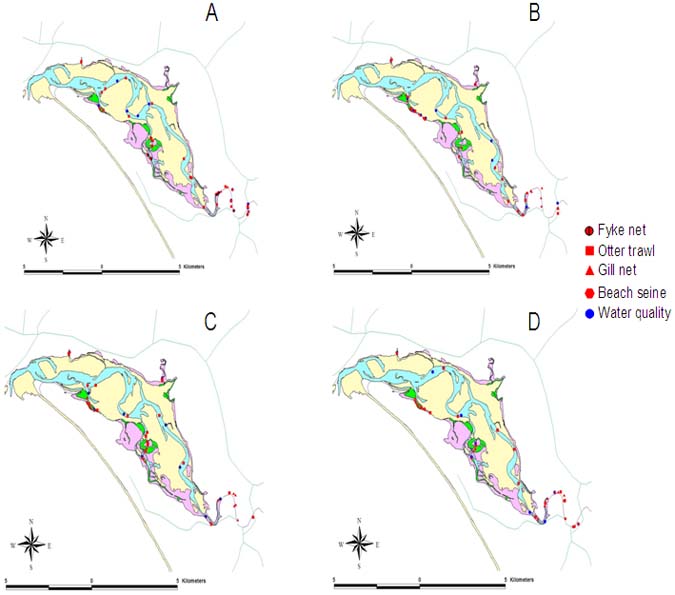
Appendix 1. Summary of the gear used to sample fish throughout Anderson Inlet. A) November 2007; B) February 2008; C) May 2008; and D) August 2008.
Appendix 3. Qualitative summary of the abundances of species sampled with each gear type. √ < 10 individuals sampled. √√ 10 to 50 individuals sampled. √√√ > 50 individuals sampled
| Common name | Fyke net | Mesh net | Seine net | Otter trawl |
|---|---|---|---|---|
| Australian smelt | √ | |||
| Black bream | √ | √ | √ | |
| Bridled goby | √ | √√ | ||
| Bridled leatherjacket | √ | √ | ||
| Climbing galaxiid | √√ | |||
| Cobbler | √ | |||
| Common jollytail | √√ | |||
| Eastern Australian almon | √√ | √√ | ||
| Eastern Blue-spot goby | √√ | |||
| Elongate hardyhead | √ | |||
| Estuary perch | √ | √√√ | √ | √√√ |
| Flathead gudgeon | √ | √ | ||
| Glass goby | √√√ | |||
| Globefish | √ | |||
| Greenback flounder | √ | √ | √√√ | |
| Gummy shark | √ | |||
| King george whiting | √ | √ | ||
| Lagoon goby | √√ | |||
| Long-finned goby | √√ | |||
| Longsnouted flounder | √√√ | |||
| Luderick | √ | |||
| Old wife | √ | |||
| Port phillip pipefish | √ | |||
| Pugnose pipefish | √√ | |||
| Red Rock cod | √ | √√ | ||
| Red Rock cod (soldierfish) | √ | |||
| Rock flathead | √ | √ | ||
| Rock whiting | √√ | √ | ||
| Rough toadfish | √√√ | |||
| Sand flathead | √ | √√ | ||
| Sand mullet | √ | |||
| Sandy sprats | √√ | √ | ||
| Shortfin eel | √ | |||
| Silver trevally | √ | √ | ||
| Six-spined leatherjacket | √ | |||
| Smooth toadfish | √√ | √√ | √√ | √√√ |
| Snapper | √ | |||
| Southern crested weedfish | √ | |||
| Sparsely-spotted stingaree | √ | |||
| Spotted pipefish | √ | |||
| Tailor | √ | |||
| Tamar river goby | √ | √√ | ||
| Tommy rough | √ | |||
| Tupong | √ | √ | √ | |
| Wide-bodied pipefish | √ | |||
| Yank flathead | √ | √ | ||
| Yellow-eye mullet | √√√ | √ | √ |
Appendix 4. Qualitative summary of the abundances of species sampled in each major habitat type. √< 10 individuals sampled. √√ 10 to 50 individuals sampled. √√√ > 50 individuals sampled.
| Common name | Channel | Mangrove | Phragmites | Rock Wall | Seagrass | Spartina | Tarwin river |
|---|---|---|---|---|---|---|---|
| Australian smelt | √ | ||||||
| Black bream | √ | √ | |||||
| Bridled goby | √√ | √ | √ | ||||
| Bridled leatherjacket | √ | √ | |||||
| Climbing galaxiid | √√ | ||||||
| Cobbler | √ | √ | √√ | √ | |||
| Common jollytail | √ | √ | √√√ | ||||
| Eastern Australian Salmon | √√ | √√ | √ | √ | √ | ||
| Eastern Blue-spot goby | √ | √√ | |||||
| Elongate hardyhead | √ | ||||||
| Estuary perch | √√√ | √√√ | √√ | √ | √ | √√ | √√ |
| Flathead gudgeon | √ | ||||||
| Glass goby | √√ | √√√ | |||||
| Globefish | |||||||
| Greenback flounder | √√ | √ | √ | √ | √ | √√√ | |
| Gummy shark | √ | ||||||
| King george whiting | √ | √ | |||||
| Lagoon goby | √√ | ||||||
| Long-finned goby | √ | √√ | |||||
| Longsnouted flounder | √√√ | √ | √ | ||||
| Luderick | √ | ||||||
| Old wife | √ | ||||||
| Port phillip pipefish | √ | ||||||
| Prickly toadfish | √√ | √ | √√ | ||||
| Pugnose pipefish | √ | √ | |||||
| Red Rock cod | √√ | √ | |||||
| Red Rock cod (soldierfish) | √ | ||||||
| Rock flathead | √ | ||||||
| Rock whiting | √√ | ||||||
| Sand flathead | √ | √ | |||||
| Sandy sprats | √√ | ||||||
| Sea mullet | √ | ||||||
| Silver trevally | √ | √ | √ | ||||
| Six-spined leatherjacket | √ | ||||||
| Smooth toadfish | √√√ | √√√ | √ | √√ | √ | √√ | |
| Snapper | √ | ||||||
| Southern crested weedfish | √ | ||||||
| Sparsely-spotted stingaree | √ | ||||||
| Spotted pipefish | √ | ||||||
| Tailor | √ | √ | |||||
| Tamar river goby | √ | √ | √ | √ | √ | ||
| Tommy rough | √ | ||||||
| Tupong | √ | √ | √ | √ | √ | ||
| Wide-bodied pipefish | √ | ||||||
| Yank flathead | √ | √ | √ | ||||
| Yellow-eye mullet | √ | √√√ | √ | √ | √ | √ | √ |
| Total number of species | 26 | 23 | 9 | 3 | 24 | 10 | 16 |
Appendix 6. Summary of the fish, invertebrate and source (plant) samples collected in Anderson Inlet for carbon and nitrogen stable isotope analyses.
|
Site |
||||||
| Sample | Species | Inlet | Pound Creek | Screw Creek | Tarwin River | VenusBay |
|---|---|---|---|---|---|---|
|
Fish |
Estuary Perch A (Macquaria colonorum) |
v |
v |
v |
v |
|
|
Estuary Perch J |
v |
v |
v |
|||
|
Prey |
Blue Sprat (Spratelloides robustus) |
v |
||||
|
Common jollytail (Galaxias maculatus) |
v |
|||||
|
Silverfish (Leptatherina presbyteroides) |
v |
v |
v |
|||
|
Bay prawn (Metapenaeus bennettae) |
v |
|||||
|
Grass shrimp (Macrobrachium spp.) |
v |
v |
v |
v |
||
|
Pygmy squid (Idiosepius notoides) |
v |
|||||
|
wide bodied pipefish (Stigmatopora nigra) |
v |
|||||
|
Yellow-eye mullet (Aldrichetta forsteri) |
v |
v |
||||
|
Hymenosomatid crabs |
v |
|||||
|
Grapsid crab |
v |
|||||
|
Source |
Phytoplankton 1 |
v |
v |
v |
v |
|
|
Brown algae |
v |
v |
v |
|||
|
Green algae |
v |
v |
||||
|
Mangrove |
v |
v |
v |
v |
v |
|
|
Melaleuca |
v |
|||||
|
Phragmites |
v |
v |
||||
|
Red algae |
v |
|||||
|
Saltmarsh |
v |
|||||
|
Seagrass |
v |
v |
v |
v |
||
|
Spartina |
v |
v |
v |
v |
v |
|
|
Phytoplankton 2 |
v |
v |
v |
Appendix 9. Variation in stable carbon and nitrogen isotopes of estuary perch with change in fish size (fork length) across each sampling location within Anderson Inlet.
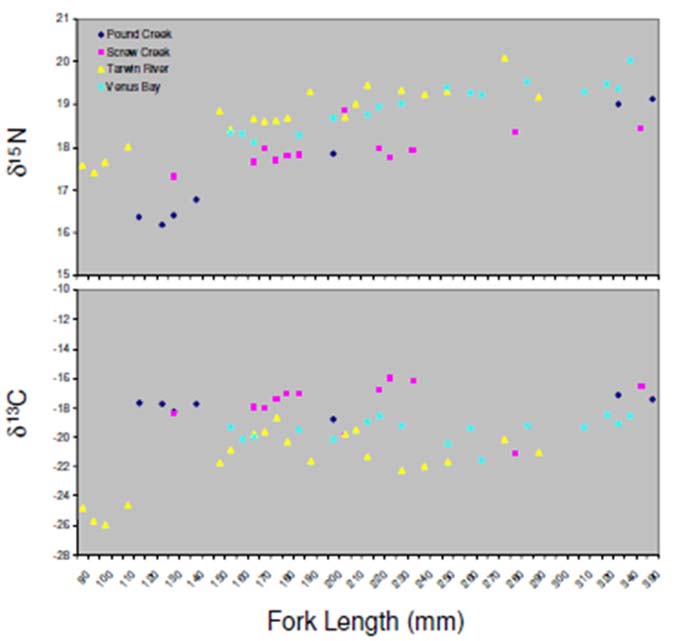
Appendix 9. Variation in stable carbon and nitrogen isotopes of estuary perch with change in fish size (fork length) across each sampling location within Anderson Inlet.
Appendix 10. Multidimensional scaling plot, based on Bray-Curtis dissimilarity metrics, comparing estuary perch of different sizes among sampling locations in Anderson Inlet.
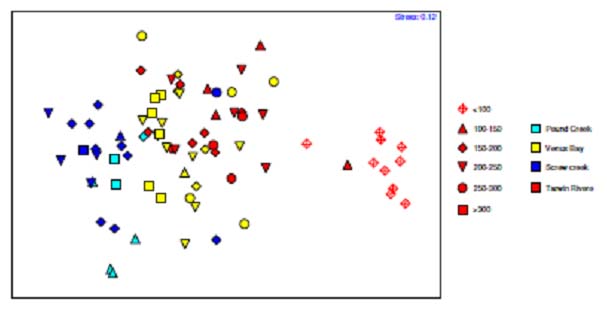
Appendix 10. Multidimensional scaling plot, based on Bray-Curtis dissimilarity metrics, comparing estuary perch of different sizes among sampling locations in Anderson Inlet.
Appendix 11. Frequency proportional distributions, based on carbon isotopes only, of feasible contributions by alternative sources to the nutrition of juvenile (< 200 mm fork length) and adult estuary perch adjusting for 2 and 3 levels of trophic enrichment above sources. BA = brown algae, GA = green algae, Mn = mangrove, Ph = Phragmites, SG = seagrass, Sp = Spartina, Phyto = phytoplankton and BMA = benthic microalgae.
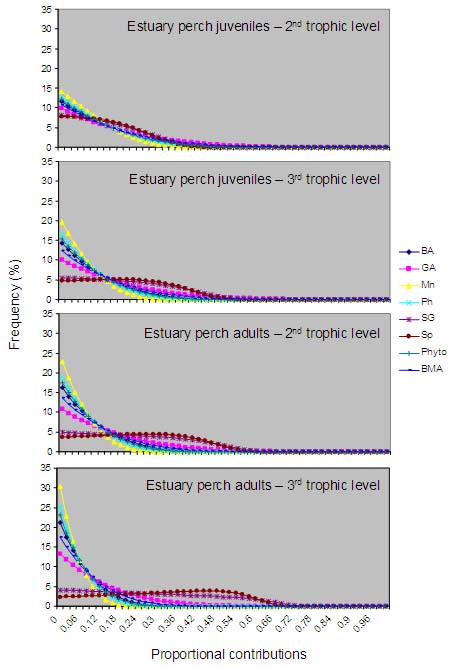
Appendix 11. Frequency proportional distributions, based on carbon isotopes only, of feasible contributions by alternative sources to the nutrition of juvenile (< 200 mm fork length) and adult estuary perch adjusting for 2 and 3 levels of trophic enrichment above sources. BA = brown algae, GA = green algae, Mn = mangrove, Ph = Phragmites, SG = seagrass, Sp = Spartina, Phyto = phytoplankton and BMA = benthic microalgae.
Appendix 12. Mean (black squares), 99%ile (+) and 1%ile (-) proportional contributions of sources (green algae, mangrove, Phragmites, seagrass, Spartina).
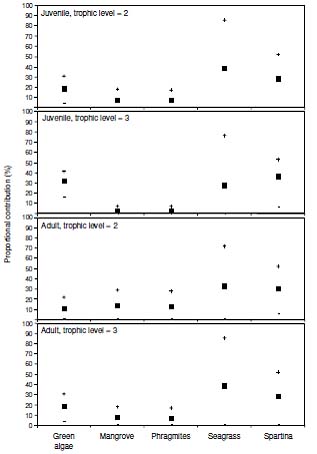
Appendix 12. Mean (black squares), 99%ile (+) and 1%ile (-) proportional contributions of sources (green algae, mangrove, Phragmites, seagrass, Spartina).
